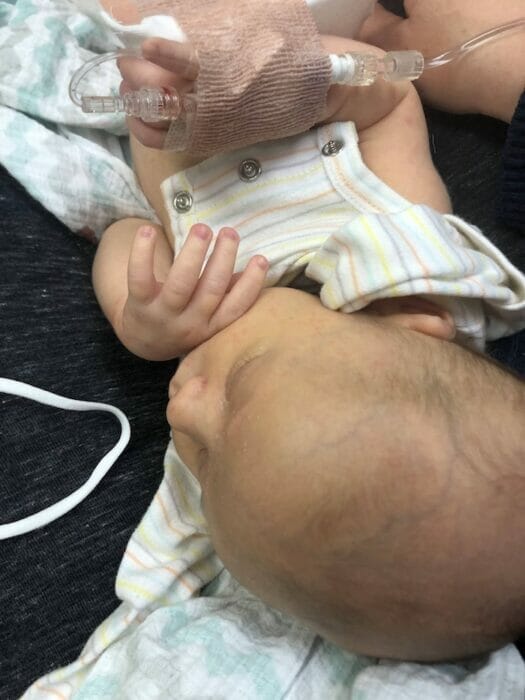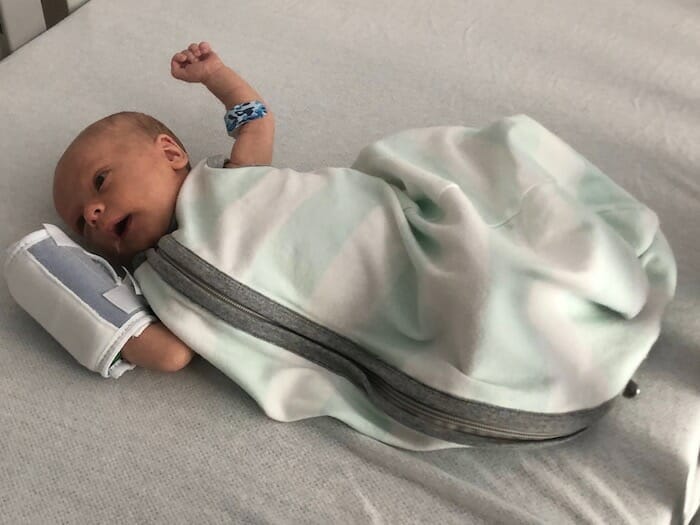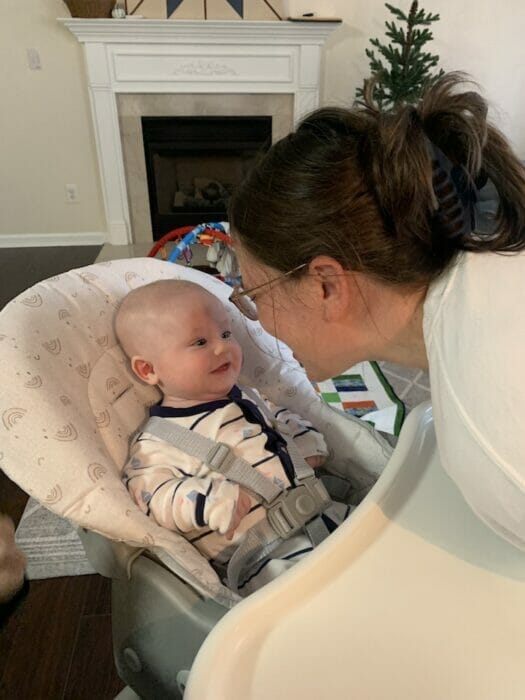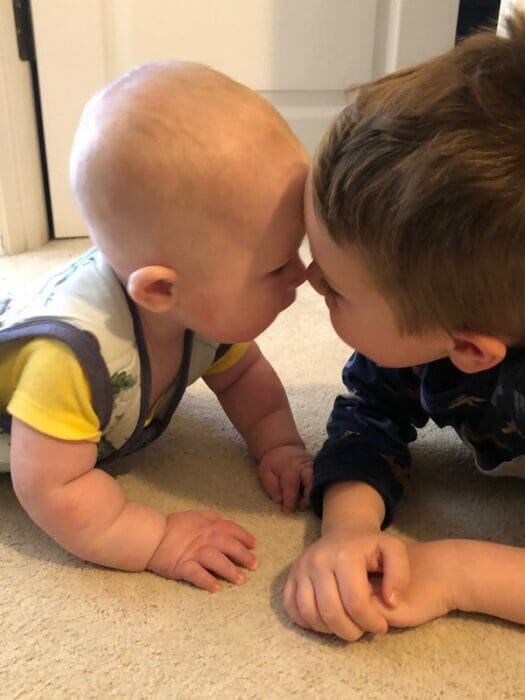Elliot joined our lives on July 29th of 2022. We eagerly anticipated his arrival and were thrilled to become a family of four. We expected the sleepless nights, the behavioral regressions of our then three-year old adjusting to life as a big brother, and the growing pains balancing the needs of another small human. What we did not expect was the frightening trial we would face in the weeks to come.
I first noticed mucus in Elliot’s stool early in the afternoon of August 30th. His bowel movements became more frequent as the day progressed until every diaper change contained diarrhea. Throughout the night he began audibly straining, grunting, and his abdomen became rigid with each movement. I started taking his axillary temperature just after midnight and I felt my anxiety rise as I noticed a low-grade fever develop. I wracked my brain to consider a cause or source of his symptoms. I was breastfeeding and supplementing with only a couple daily ounces of powdered infant formula from a sample canister given to us by the pediatrician due to concerns about Elliot’s weight gain. Did he have a virus? Was it the edamame I had eaten the night before that was causing him digestive problems? Perhaps this was an indication of a soy intolerance. Regardless, I was concerned and aware of all the additional cautionary measures necessary when an infant becomes ill within their fragile first three months of life. Early the morning of August 31st, I scheduled a same-day sick appointment with our pediatrician’s office.

At the time of his appointment, Elliot’s temperature was normal, but the nurse kindly offered to demonstrate effective rectal temperature practices. The doctor encouraged vigilance regarding dehydration and feeding, and she reminded me that a fever of 100.4 rectally would require a visit to the hospital’s emergency department. If Elliot’s diarrhea persisted for the next few days, we could schedule a follow-up appointment if we felt it necessary. I left the office concerned and defeated without a solution for the problem at hand. My husband promptly purchased an additional thermometer for our rectal temperature attempts. When Elliot became markedly lethargic later in the day, we discovered that his temperature had reached the dreaded 100.4 threshold. Without skipping a beat, we headed to the emergency department of our local hospital. Over the next several hours Elliot was subjected to the comprehensive testing protocol for infants under three months of age presenting with a fever. This included a chest X-ray, blood culture, urine culture, and stool culture. As the team of medical providers worked to find equipment small enough for a baby his size, I was scared but validated that my earlier concerns were now considered well founded by the experts. The hours slowly passed by as the nurses worked diligently to collect the samples necessary for numerous diagnostic tests. We held Elliot and kept him precariously attached to the small plastic collection bag taped to his tiny body while we waited until he could produce a urine and stool sample. We were at the mercy of time and grace, and whatever his tiny body would produce.

At 4:30am the next morning, nearly 12 hours after our arrival, we were sent to the children’s hospital for observation and fluids as we awaited the results of Elliot’s extensive testing. As parents of a one-month old, my husband and I thought we had already reached capacity for sleep deprivation but a night in the emergency room brought a whole new level of stress-induced exhaustion. When the blood culture results came back positive for Salmonella, a repeat test was ordered. Doctors considered that perhaps the blood sample had been contaminated. After all, it’s exceedingly rare for an infant to contract Salmonella. Antibiotics were ordered with his IV in the interim for safe measure and, when the results of the stool culture showed heavy growth for the pathogen, a lumbar puncture was deemed immediately necessary to determine whether the blood infection had reached the spinal cord developing into meningitis. A team of specialists entered our room and asked our permission to perform the delicate procedure. It was highly recommended, and we needed results to determine if life changing long-term brain damage had already occurred. It is difficult to articulate what it felt like to watch my child, so fresh to the world that I barely knew him yet, undergo such painful diagnostic testing, or have an IV placed in his little hands, and then his head, and finally both feet. At some point, I turned off my feelings and ceased to emotionally process it all. We were so grateful to learn that meningitis was not a concern that it softened the blow when we were told that Elliot would need to remain in the hospital for the next several days to receive the full course of his antibiotic treatment via IV.

As I allowed myself to feel the hope and gratitude of a positive prognosis, all the “what-ifs” began to intrude. What if we hadn’t taken his temperature when we did? What if the infection continued to progress without intervention for even 12hrs longer? What if Elliot had been older than 3 months and the extensive testing wasn’t considered immediately necessary? Certainly, we were fortunate that this pathogen would not reach its full potential and destroy the body of our child. The helplessness of not knowing how we had found ourselves in this situation to begin with was maddening. My mind turned to the question that plagued me at the first sign that something wasn’t right with my baby just a couple days prior. What was the cause of this ordeal? Where could an exposure to something as sinister as Salmonella have occurred for one so young? No one else in our household had been sick. No recalls on anything we consumed had been issued. We have no pets. Our water is sourced from the city/county. I manage an egg-free house because my firstborn, whose first day of preschool I missed while at the crib-side of my second, has a severe egg allergy. Could the problem be the extensive plumbing repair that took place at our home in the weeks prior? What about the mouse that we caught in a trap the month before? According to the infectious disease doctors we met with, every random possible exposure scenario was highly unlikely. But our paranoia had taken hold, how would we be able protect our children from repeat exposure and infection?
Upon Elliot’s release from the hospital 9 days after our emergency department intake, I was told that it is common for a young salmonellosis patient who has been treated with an antibiotic to continue to shed the bacteria for several months to a year following the initial infection. While Elliot remained fever free and continued to be a hearty eater, his bowel symptoms persisted in the weeks following his return home. Between the stress of this ordeal and the demands of those early newborn days, I must have overlooked a diaper leak and unwittingly exposed myself to the bacteria because almost exactly a month after Elliot’s diagnosis, I contracted Salmonella presumably from him. I previously had questioned whether it was possible for one of us to have been unknowingly infected and transmitted the bacteria to Elliot. But after being incapacitated for a full week, battling stomach cramps, and struggling to stay hydrated, I don’t believe it would have been possible for anyone in our household to have been sick and unaware. It felt right to suffer in the way that my child had suffered and oddly I was grateful for the opportunity to feel what he felt in those difficult days battling the infection. But then again, it added another layer of trauma to our ordeal and even more fear to the path of recovery.
In the months that followed, Elliot has continued to test positive for Salmonella growth with each new stool culture and I work diligently to prevent his reinfection and protect the rest of my family. I avoid long outings that may involve diaper changes because I refuse to expose others to the threat of this experience. My hands bleed daily from all the preventative washing, sanitizing, and disinfecting. I spend over $100 a month on cleaning products for diaper changes and baths alone. I hope that this infection will be a distant memory before Elliot’s first birthday, but we have just 4 shorts months remaining until that milestone comes to pass. It is heartbreaking to know that it will be impossible to reflect on his first months of life without also recalling the trauma of his illness and the violation of a seemingly untraceable pathogen.



On the heels of the formula recall and subsequent shortage earlier in 2022, Elliot’s medical team searched for recalls involving our canister and found nothing. In conversations with multiple medical professionals, the possibility of formula contamination as the source of exposure has been suggested. Through research, I understand that Cronobacter sakazakii has been the primary focus of formula contamination in recent history, but Salmonella is another microorganism commonly traced to contaminated powdered formula. Two weeks after I was tested for Salmonella, I was contacted by my state health department and asked the series of questions I was already familiar with to determine the possibility of an outbreak. I explained the situation, the likelihood that I contracted the bacteria through Elliot, and I asked what I should do with the information that infant formula was a possible initial source. The public health official explained that it would not be something that the health department would explore further since there was no traceable outbreak to their knowledge. She recommended that if I had concerns, I could report the information to the formula manufacturer as an act of due diligence. I instantly made the decision to report this information. It wasn’t even a question in my mind. If there were any chance other babies could possibly experience the same ordeal or worse, I was happy to do my part to prevent unnecessary suffering and hardship. In the email response I received from a consumer care representative at the formula company, I was assured that they follow FDA regulations, that every batch of formula is tested for Salmonella, that no sealed canister should contain the bacteria. And they closed their form letter style response by explaining how cross-contamination can occur once a consumer has opened the powdered formula.

What they didn’t include in their response is the fact that powdered formula is not a sterile product or that it’s impossible for the sample testing required by law to rule out contamination in an entire batch of formula. They also didn’t mention that while the FDA has access to the records of contamination or linked infection during periodic inspections, companies are not required to actively report information regarding positive tests or consumer complaints to the FDA. I don’t need anyone to illustrate the ways I am responsible for my infant son’s health and well-being. Regardless of the source of exposure, I will always feel responsible for not being able to protect him from that nightmare. However, I would argue that collectively we could all do more to demand stiffer regulatory practices that prevent similar occurrences of suffering from plaguing our children. As it stands, I pay the very formula company that fostered nothing but doubt and suspicion hundreds more each month for the sterile liquid option because they are one of just two producers of sterile liquid formula commonly found on our store shelves. It is not lost on me that purchasing the liquid concentrate is a cost prohibitive safety measure for many consumers, especially those who use WIC benefits to feed their children.
We are the lucky ones. Elliot was sick, but he recovered. And, although our lives were turned upside down, the only remaining indication of this hardship eventually will be the lingering trauma evident in the stories we tell about those very challenging first months of his life and the trust we lost in our regulatory systems. So many stories of infants who contract harmful bacteria through suspected contaminated formula, despite the meticulous attention of their caregivers, do not end this way. So many of these stories end with a lifetime of medical bills, ongoing therapies to manage the resulting diagnoses, and permanent health complications of bacterial infection. And worse, other stories are cruelly cut short, ended before they even had a chance to turn the first page. It is not asking too much to expect accountability. It is truly the least we should do.



